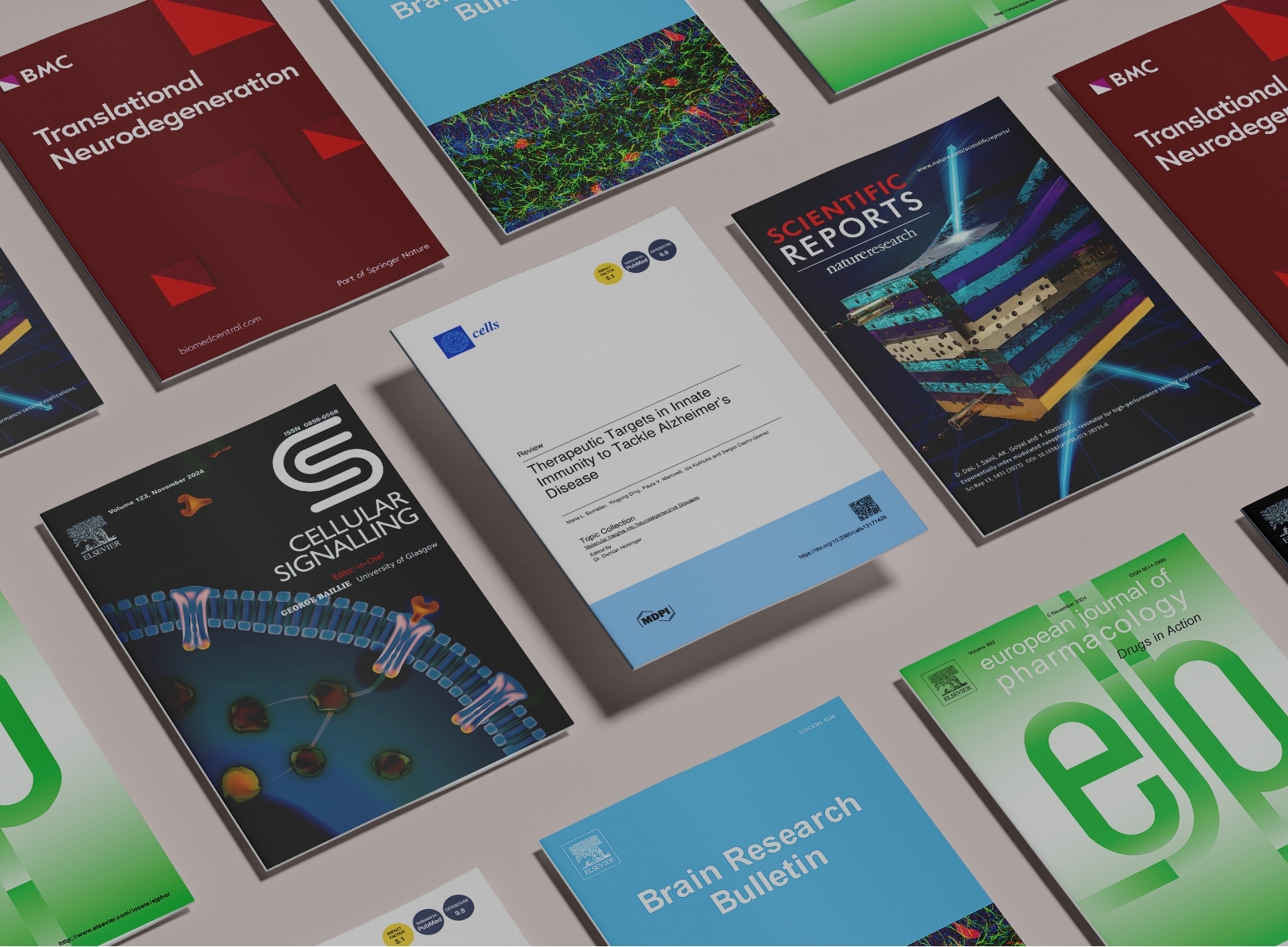Frequently Asked Questions (FAQs)
Find out more about TauRx, Alzheimer's and how our work could impact those living with the disease

Curious about tau protein
and its significance in
neurodegenerative diseases?
This FAQ section addresses common questions about tau, its role in conditions like Alzheimer’s disease and how it relates to our research. We’ve compiled clear, concise answers to help both scientific and non-scientific audiences better understand this crucial aspect of our work.
-
Who are we?
TauRx was founded in 2002 and is a leader in tau-based Alzheimer’s disease research. Professor Claude M. Wischik, co-founder and Executive Chairman of TauRx, along with colleagues at the University of Aberdeen, has devoted decades to investigating the structure and role of tau tangles in the development of Alzheimer’s disease, frontotemporal dementia (FTD) and other neurodegenerative diseases. He is the original discoverer of the composition of the tau protein pathology in Alzheimer’s disease.
-
What is tau?
The brain has approximately 86 billion interconnected neurons which communicate via electrical signals and chemical exchanges. Within each neuron, tau protein supports neuronal signaling and maintenance of cellular structure by binding and stabilizing microtubules.
Tau protein is critical for the normal function of your brain cells. It has a very important role in stabilising the structure of these cells and how they talk to one another.
-
What are tau tangles?
In Alzheimer’s disease, tau proteins can become “tangled” which occurs when aggregated and misfolded tau stacks clump together. This can lead to the cells becoming toxic, ultimately causing them to swell and burst. Once the brain cell is gone, there is no repairing or regaining it.
-
How can tau pathology be measured in people?
It is currently quite difficult to accurately measure tau pathology in people, but specialist brain Positron Emission Tomography (PET) scans enable this. With the evolution of new methodologies, it is hoped that in the near future physicians will be able to measure tau pathology quickly and accurately using a simple blood test.
-
Is TauRx involved in Alzheimer’s disease diagnosis?
TauRx collaborates with Genting Berhad to create the joint venture GT Diagnostics, which aims to change the diagnostic landscape of dementia by developing the much-needed tools required for the early diagnosis and monitoring of its progression.
Its focus is on using digital tools to address the bottlenecks within the diagnostic pathway, aiding clinicians to streamline dementia diagnosis. Facilitating earlier diagnosis of dementia will enable more timely interventions, such as treatments and lifestyle changes.
Diagnostic developments are complementary to TauRx’s research expertise, which is focused on developing treatments to address these conditions.
-
What is hydromethylthionine mesylate (HMTM)?
Hydromethylthionine mesylate (HMTM) is a chemical compound designed for early intervention to modify the underlying disease process and to slow progression of Alzheimer’s disease. It has the potential to be the first oral, anti-tau therapy requiring minimal testing and treatment monitoring for the treatment of Alzheimer’s disease.
-
Who will HMTM benefit?
Based on the clinical study design, HMTM is being targeted to benefit those individuals with mild cognitive impairment due to Alzheimer’s disease and Mild to Moderate Alzheimer’s disease.
HMTM is currently being assessed by the UK’s Medicines and Healthcare products Regulatory Agency (MHRA) as a potential new treatment for people living with Alzheimer’s disease.
We believe it is a first line treatment option and earlier intervention may prove to be most beneficial.
-
How is HMTM administered?
HMTM is a small film-coated tablet that will be administered orally. It is hoped the simple tablet formulation may offer a real opportunity to all patients to access treatment in the shortest time following diagnosis.
-
How safe is HMTM?
HMTM has a strong safety profile as evidenced by approximately 3,000 patients who have participated in our clinical trials and our expanded access programmes. Some patients have been taking HMTM for over 10 years and HMTM does not require any expensive tests nor scans as part of its routine safety monitoring.
-
Who will be able to access HMTM?
Our priority has always been helping the millions of patients with Alzheimer’s disease and their families with the development of a safe and effective treatment and working to maximise access to it. Dementia does not discriminate. Alzheimer’s disease is a global problem – it’s a disease that may affect everyone in some way.
HMTM is an easily administered oral drug. Its established safety profile, as shown in the collected clinical trial data for approximately 3,000 patients, is anticipated not to result in extensive monitoring burden for healthcare systems. However, it is important to note that accessibility to all drugs is guided by regulators, and TauRx will work with all parties concerned.
According to the World Health Organization, the global cost of dementia care is forecast to reach US $2.8 trillion by 2030, potentially overwhelming healthcare systems. We can expect that accessible, cost-effective and simple new treatments, along with advancing inexpensive diagnostics, will support transformation of dementia care and the wider socioeconomic impact of the disease.
-
How does tau treatment compare with amyloid treatments?
Current approved anti-amyloid treatments have a different mode of action and require more complex testing, administration and safety monitoring. Each individual case is different, so there may be instances where a combination of treatments will work best for a person with Alzheimer’s disease. No combination studies of developing treatments have yet been undertaken however, collaboration remains a cornerstone of life sciences research.
-
When and where will HMTM be available?
Every country’s regulatory body will carefully and fairly scrutinise every drug seeking market approval. Quite rightly, the standards are very high, and we will look to satisfy those within the regulatory processes. TauRx is currently engaged with regulators. In the UK, HMTM has an innovation passport granted by the MHRA in 2022, which confirms and acknowledges the innovative potential of this product, in the unmet need that is Alzheimer’s disease. It is a long journey to regulatory approval, but TauRx is committed to bringing new, accessible treatments in Alzheimer’s disease, to help patients and their loved ones.
-
What is the difference between dementia and Alzheimer’s disease?
As defined by Alzheimer’s Disease International, dementia is a collective name for brain syndromes which affect memory, thinking, behaviour and emotion, and is the leading cause of disability and dependency among the elderly. Alzheimer’s disease (AD) is the most common cause of dementia. Other causes include vascular disease, dementia with Lewy bodies, and fronto-temporal dementia.
-
How big a problem is Alzheimer’s disease?
Statistics from Alzheimer’s Disease International show that around the world there were more than 50 million people living with dementia in 2020, with someone developing the disease every 3 seconds. In the time it’s taken you to read that sentence, approximately three more people have developed it.
It’s predicted this number will increase to 78 million by the end of this decade, and reach 139 million in 2050. Already 60% of people with dementia live in low- and middle-income countries, but by 2050 this will rise to 71%. The fastest growth in the elderly population is taking place in China, India and their South Asian and Western Pacific neighbours.
The global cost of dementia is forecast to reach nearly US $3 trillion by 2030, which could overwhelm healthcare systems. In the United States alone, the cost of Alzheimer’s disease is forecast to be $1 trillion in 2050.
Alzheimer’s disease has an even wider impact on families. For example, in the United States, there are more than 11 million unpaid caregivers who provide 16 billion hours of unpaid care annually. This has an economic value of $271.6 billion.
To put everything into context, around 20 people have developed dementia since you started reading the answer to this question.
-
Why has it taken so long to get to this point?
Medical science always takes time because we need to be sure a treatment will produce the best results for people with Alzheimer’s disease – they are central to everything we do. TauRx is the first life sciences company to complete a phase 3 clinical trial targeting the tau pathology of Alzheimer’s disease, and has been the pioneer of tau aggregation research. For the last few decades, teams at TauRx have worked tirelessly to create a safe, effective and affordable treatment.
Every drug on the market has gone through this type of gradual development. It’s important to be flexible and adaptive – that’s how to get to the point we’re at now of submitting the relevant documentation to regulators and we are determined to do everything we can to get a treatment to those who need it most
-
Has TauRx developed a cure for Alzheimer’s disease?
Unfortunately, there is currently no cure available for Alzheimer’s disease. However, it is hoped HMTM will become the world’s first oral tau-based treatment that will slow progression of the disease, with studies showing that benefit can be maintained over a two-year period. HMTM has the potential to benefit the lives of millions of people worldwide.


